The 10 Best Gig Economy Platforms To Find Work In 2024
By Adrian Mole Updated: Feb 28, 2024

Find the best jobs available on the most trusted sites.
You can't escape from the fact that we're in a technology-driven era with the gig economy platforms growing as traditional employment drops off.
Whether you're looking for a temporary job to boost your income as an independent contractor, online platforms are a great place to start.
More and more businesses are leveraging these platforms to discover freelancers or independent contractors for task-specific roles, avoiding needing full-time staff.
The 10 Best Gig Economy Platforms To Find Work In 2024
With projections suggesting that more than 50% of the U.S. workforce will be part of the gig economy in 2024, we've curated a list of the leading gig economy platforms.
Rather than just a fixed price, gig economy platforms offer freelancers the opportunity to bid on jobs based on their willingness to negotiate rates.
Start your job search with this list of the 10 best gig economy platforms to find work in 2024.
10. DoorDash
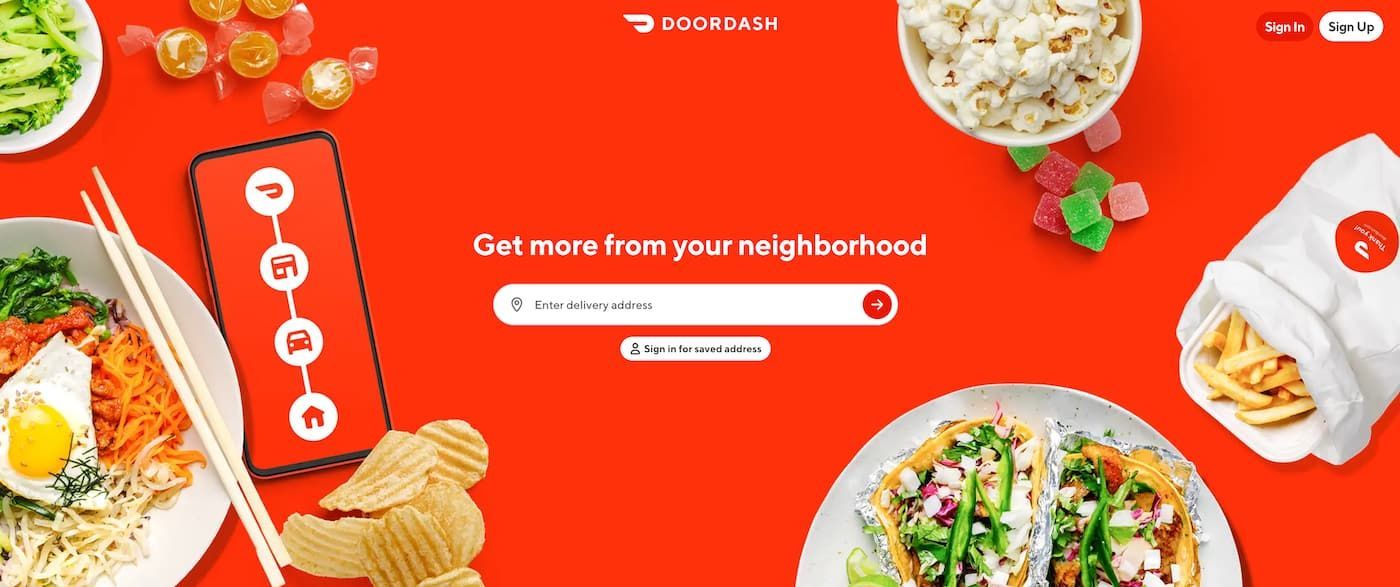
DoorDash is a popular on-demand food delivery service that connects customers with local restaurants, allowing them to order and deliver meals to their doorstep.
Individuals, known as Dashers, sign up to deliver food locally using their own vehicles and earn money based on completed deliveries.
The DoorDash app lets customers place orders, which Dashers then receive and deliver, creating a seamless and efficient process for both users and drivers.
Becoming a Dasher allows gig workers great flexibility in choosing working hours, making it ideal for those looking for part-time or flexible gig work.
Customer tips make up a significant portion of Dashers' income on top of their delivery fee, which provides an additional source of income.
It makes sense to check out some of the gig economy pros and cons related to working for DoorDash before diving in.
Pros:
- DoorDash operates in many cities throughout the country, providing a wide range of opportunities for gig workers.
- Dashers can choose when to work, allowing for a flexible schedule.
- The harder one works, the more money a Dasher can earn.
Cons:
- Dashers are responsible for their vehicle expenses, including gas, which can negatively impact their overall earnings.
- The gig economy for food deliveries can be competitive, with new entrants leading to increased competition.
- Dashers are subject to customer ratings, with low ratings affecting their acceptance of future gig jobs.
Bottom Line:
DoorDash operates across many cities throughout the US, providing ample opportunities for gig work, while Dashers can increase earnings through customer tips.
However, Dashers are responsible for vehicle expenses, including gas, which can impact their overall earnings in a competitive food delivery environment.
9. Uber Eats

Uber Eats is one of the most popular gig economy platforms that operates as a subsidiary of Uber, allowing users to order meals from local restaurants.
The meals are then delivered by Uber Eats drivers, who are independent contractors employed as driver-partners who fulfill food delivery requests.
It's a sophisticated business that allows users to place food orders through the Uber Eats app, with driver-partners receiving delivery requests via the same platform.
Uber Eats provides flexibility for driver-partners to choose their working hours, making it suitable for those seeking part-time or flexible gig opportunities.
Drivers earn money based on completed food deliveries, and customers have the option to tip for good service and rate the service.
As one of the biggest gig economy companies in the world, Uber is able to offer gig workers unsurpassed branding and opportunities.
Pros:
- Uber Eats is one of the most widely recognized gig economy platforms that attracts more customers.
- Similar to DoorDash, Uber Eats offers flexibility in choosing working hours.
- Demand for the service is high.
Cons:
- Drivers are responsible for the wear and tear on their vehicles.
- Some areas are very competitive, with high numbers of Uber Eats drivers increasing competition.
- Earnings vary throughout the day, especially during off-peak periods and in less populated areas, resulting in low earnings.
Bottom Line:
Uber Eats stands out as one of the most widely recognized gig economy platforms, offering flexible opportunities for driver-partners to deliver meals from local restaurants.
The platform provides flexibility in choosing working hours, attracting a large customer base attracted by the branding of one of the biggest gig economy companies.
8. LinkedIn
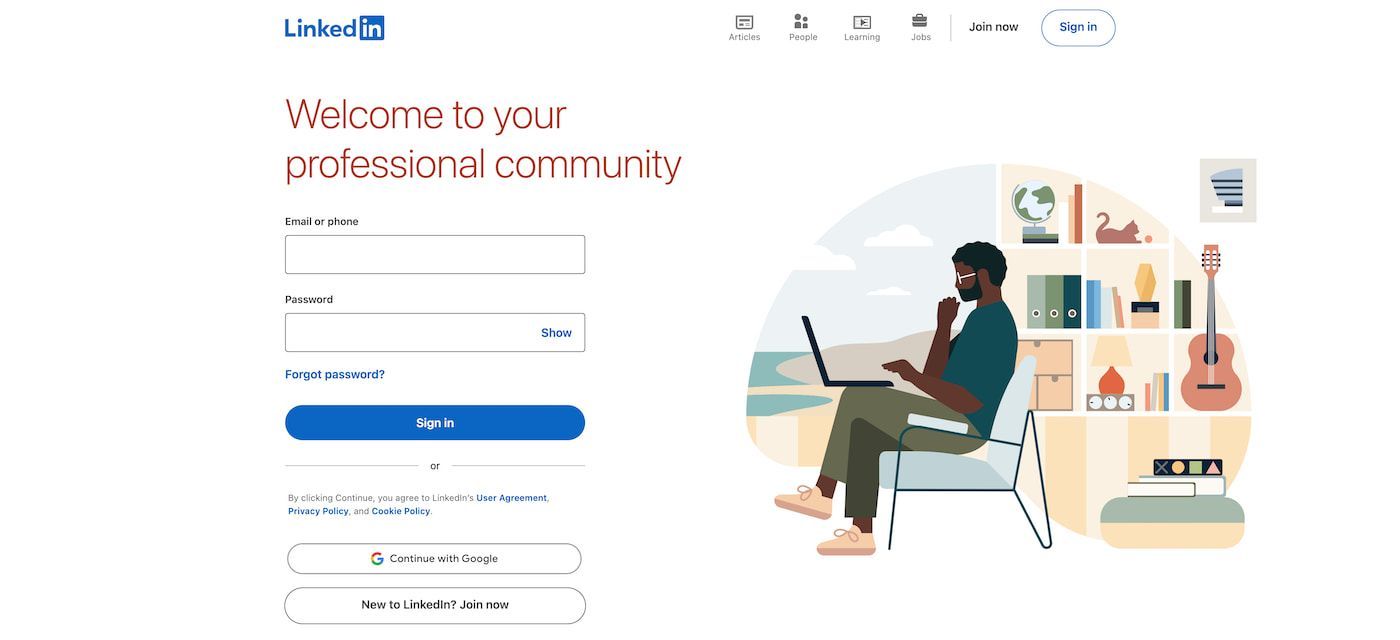
LinkedIn is a social media platform designed for professional networking, connecting individuals with career opportunities, colleagues, and industry professionals.
In addition to networking, LinkedIn serves as a job board where users can find job listings and explore career opportunities.
It is one of the gig economy platforms that has led the way in popularizing non-traditional work and offers great opportunities for new entrants into the market.
Users create professional profiles highlighting their skills, experiences, and achievements, making it a great platform for personal branding and career development.
Beyond gig jobs search, LinkedIn focuses on helping members build professional relationships, making it a valuable resource for business networking and collaboration.
You can assist companies with tasks like filing taxes, ensuring they follow basic accounting principles and more.
Pros:
- LinkedIn is a professional network that provides you with direct access to decision-makers.
- The gig jobs listed are of higher quality when compared to other gig platforms.
- The platform caters to all industries, offering gigs in multiple fields.
Cons:
- LinkedIn isn't a traditional gig economy platform, so gig opportunities may be fewer than dedicated gig platforms.
- The website lacks features specific to gig work platforms, such as built-in payment systems.
- It is a highly competitive environment for professional gigs, making it difficult for a new gig worker to gain traction.
Bottom Line:
While LinkedIn is primarily a professional networking website, it serves as a popular platform for gig opportunities and job listings.
New entrants into the gig economy can build professional profiles for personal branding and career development, gaining direct access to key decision-makers.
7. Guru

Guru is another of the gig economy platforms that connect freelancers with employers seeking services in various fields, including writing, design, and programming.
They operate a bid-based system where freelancers bid on projects posted by employers, and the employer selects a freelancer based on their proposals and expertise.
Guru offers project management tools, allowing freelancers and gig economy companies to collaborate, track work progress, and manage payments within the platform.
The platform charges relatively low fees compared to other freelancing platforms, providing freelancers with a larger share of their earnings.
Pros:
- Guru charges relatively low fees (9%) compared to some other gig economy platforms.
- There is a free tier for freelancers and four paid tiers between $11.95 and $49.95 per month for additional services.
- Guru offers project management functionalities, aiding freelancers in tracking work and payments.
Cons:
- Limited to 10 bids per month on the free tier.
- The free tier lacks certain features that make it less competitive.
- The platform has a complex fee structure that is not newbie-friendly.
Bottom Line:
Guru’s bid-based system, project management tools, and relatively low 9% fee make this an attractive platform for freelancers on the free tier.
However, the free tier has limitations, such as a cap on bids and needing certain features, making it less competitive.
6. TaskRabbit
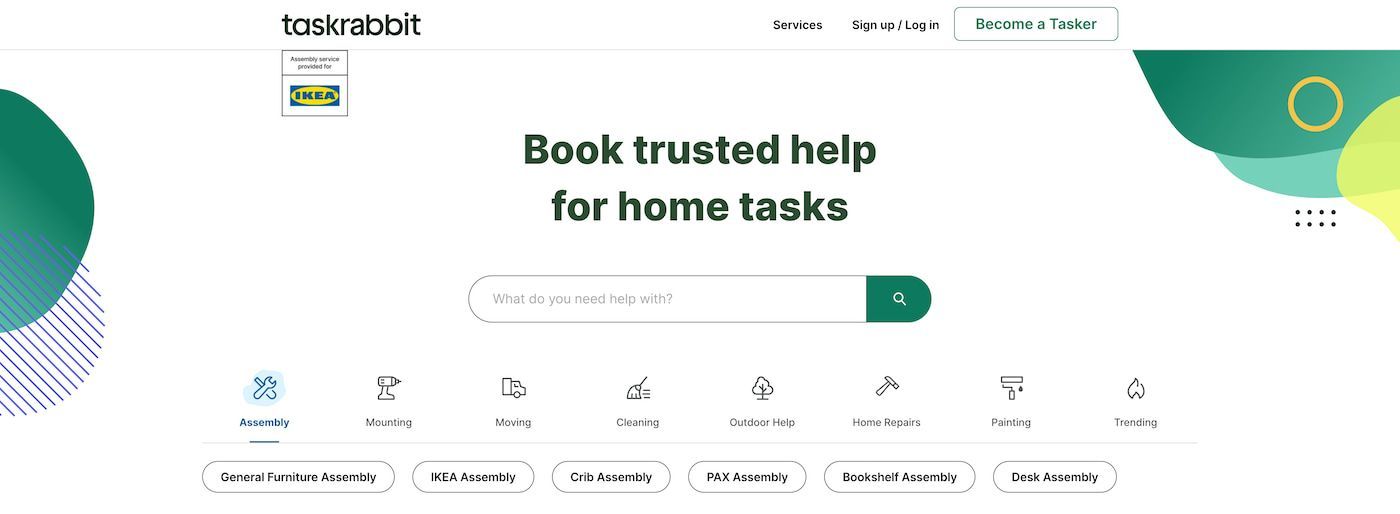
TaskRabbit is a platform that connects individuals, known as Taskers, with users who need assistance with various personal tasks and errands, such as cleaning services.
The platform offers a broad range of tasks, including furniture assembly, grocery shopping, moving assistance, and other handyman services.
Unlike some digital platforms, TaskRabbit often involves in-person interactions as Taskers physically complete tasks for users in their local area.
Taskers have the flexibility to choose when they are available to take on jobs, allowing for part-time or flexible gig work.
Like similar gig economy platforms, taskers are reviewed by users, with their ratings contributing to the taskers' reputation on the platform.
Pros:
- TaskRabbit offers a wide range of tasks that appeal to different skill sets.
- Taskers can choose when to take on tasks, allowing for plenty of flexibility.
- Some tasks may involve in-person activities, providing a unique gig experience.
Cons:
- Depending on tasks, there may be a need for in-person interaction, which may not suit everyone.
- Task availability may vary, affecting the consistency of gig opportunities.
- TaskRabbit charges a 15% fee on earnings, excluding reimbursed costs.
Bottom Line:
TaskRabbit offers a broad range of tasks, but the need for in-person interaction may not suit everyone, and task availability can impact gig consistency.
5. Flexjobs
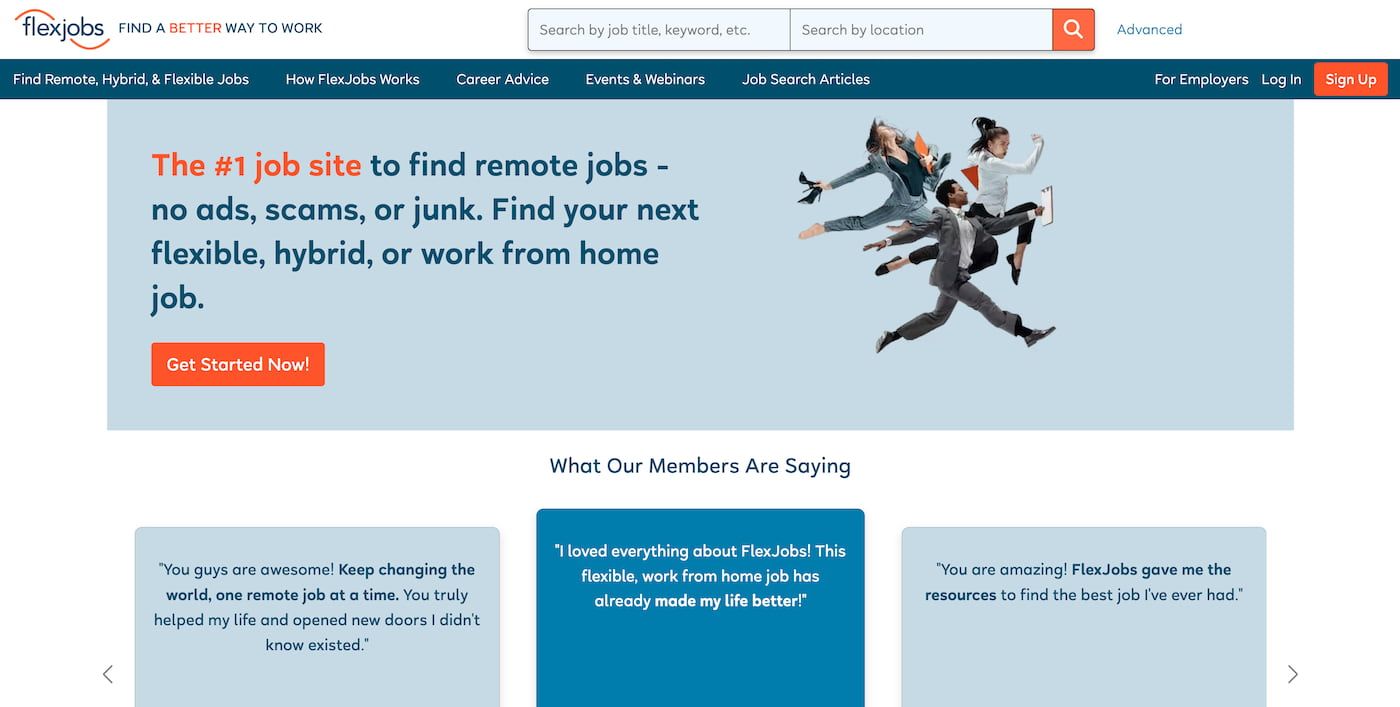
FlexJobs is an online platform that specializes in connecting job seekers with remote, flexible, and hybrid job opportunities in over 50 different categories.
Their curated database of job listings is thoroughly screened by their expert research team, which ensures the quality of each offer.
All jobs listed on the platform offer some form of flexibility, such as remote work, freelance, part-time, or flexible schedules.
Unlike other gig economy platforms, they offer one-on-one career coaching, webinars, skills tests, and video courses to help individuals enhance their skills.
Unparalleled flexibility is what the gig economy offers, allowing individuals to choose when, where, and how they work, thereby redefining traditional notions of employment.
FlexJobs vets each job and company to ensure legitimacy, helping gig workers avoid scams or illegitimate opportunities, particularly prevalent in the work-from-home job market.
Platform member perks include a range of services, from travel and leisure to career advancement, providing added value to individuals seeking flexible employment.
While FlexJobs provides some information for free, full access to their entire jobs database and additional resources is available through a subscription model.
Pros:
- FlexJobs provides extensive resources and educational tools for gig workers.
- Offers a range of verified part-time, full-time, and remote job opportunities.
- Unlike some platforms, FlexJobs does not claim a commission on earnings.
Cons:
- Due to its popularity, FlexJobs gigs are competitive.
- You need to pay for access to all the features.
- The platform may feel crowded, making it difficult to stand out.
Bottom Line:
The platform stands out for its curated and thoroughly screened job listings, providing gig workers with extensive resources and educational tools.
The popularity of FlexJobs results in increased competition for gigs, and access to the platform's full features requires a subscription fee.
4. Toptal
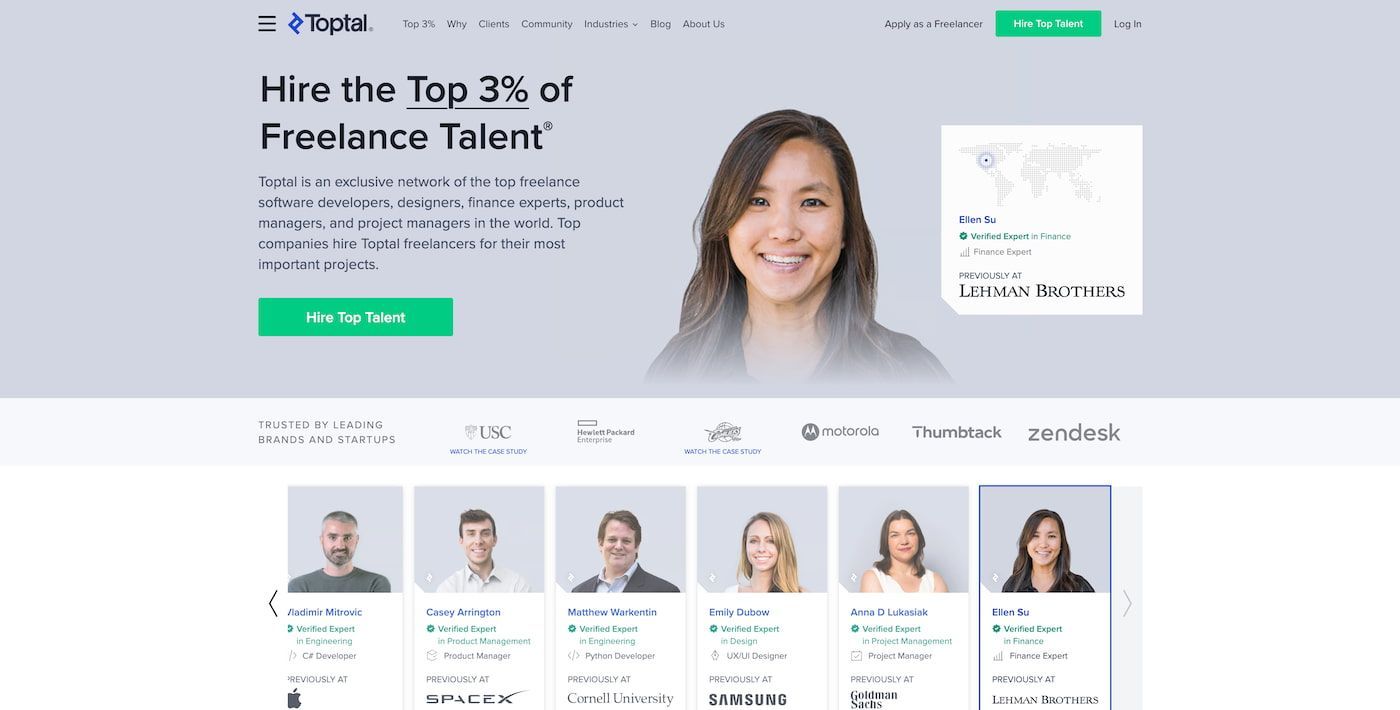
Toptal is a global remote company that connects businesses with highly skilled professionals such as software engineers, designers, finance experts, product managers, and project managers.
The platform employs a rigorous talent search process, utilizing personality, language, and skills testing to screen all candidates remotely.
Only the top 3% of candidates, of which there are several thousand each month, make the grade, ensuring a high level of expertise.
After initially focusing on software engineering, Toptal's services now include freelance designers, accountants, statisticians, and consultants across various domains, including market research and financial modeling.
The platform uses AI and live support to match freelancers with clients based on their skills, ensuring a better fit for both parties.
Toptal's drawcard is that it is more suited for technical fields like web development and finance, attracting clients looking for expert freelancers in specific industries.
Pros:
- Toptal focuses on high-quality clients, potentially leading to higher-paying opportunities.
- AI and Live Support help to match freelancers with suitable employers.
- An internal dispute resolution service simplifies conflict resolution.
Cons:
- Toptal's stringent selection process only accepts a small percentage of applicants.
- The platform is better suited to technical and finance experts with limited opportunities for creative freelancers.
Bottom Line:
Toptal’s popularity stems from being a global platform that connects businesses with highly skilled professionals through an extremely rigorous talent search process.
The platform offers great potential for higher-paying opportunities using AI and live support for effective freelancer-client matching.
However, the stringent selection process limits opportunities for creative freelancers, and the platform is best suited for those with expertise in technical and finance jobs.
3. Fiverr

Fiverr is a multinational online marketplace for business services where freelancers offer to perform various tasks for buyers at competitive rates.
The platform initially set a $5 asking price for all tasks, but sellers can charge more for different offerings based on the size of orders.
The platform focuses on digital services, and businesses can access additional products like Fiverr Business, designed to help larger companies manage workflows.
Fiverr takes a 20% commission on freelancers' earnings, so it's important to include this in your costings before setting the price for your services.
Pros:
- Unlike most gig economy platforms, Fiverr eliminates the need for bidding, saving time.
- Fiverr allows employers to extend custom offers, streamlining the job selection process.
Cons:
- The platform's interface can take some time to get used to.
- Fiverr enforces strict rules, limiting freelancers' ability to build client lists.
Bottom Line:
Fiverr has built a well-deserved multinational online marketplace for business services focusing on digital tasks and competitive pricing.
The platform's absence of bidding on jobs saves freelancers time, while the custom offers option makes this a potentially lucrative gig source.
The strict rules can limit freelancers' ability to build client lists, but it’s a trusted and popular resource for many successful freelancers.
2. Freelancer
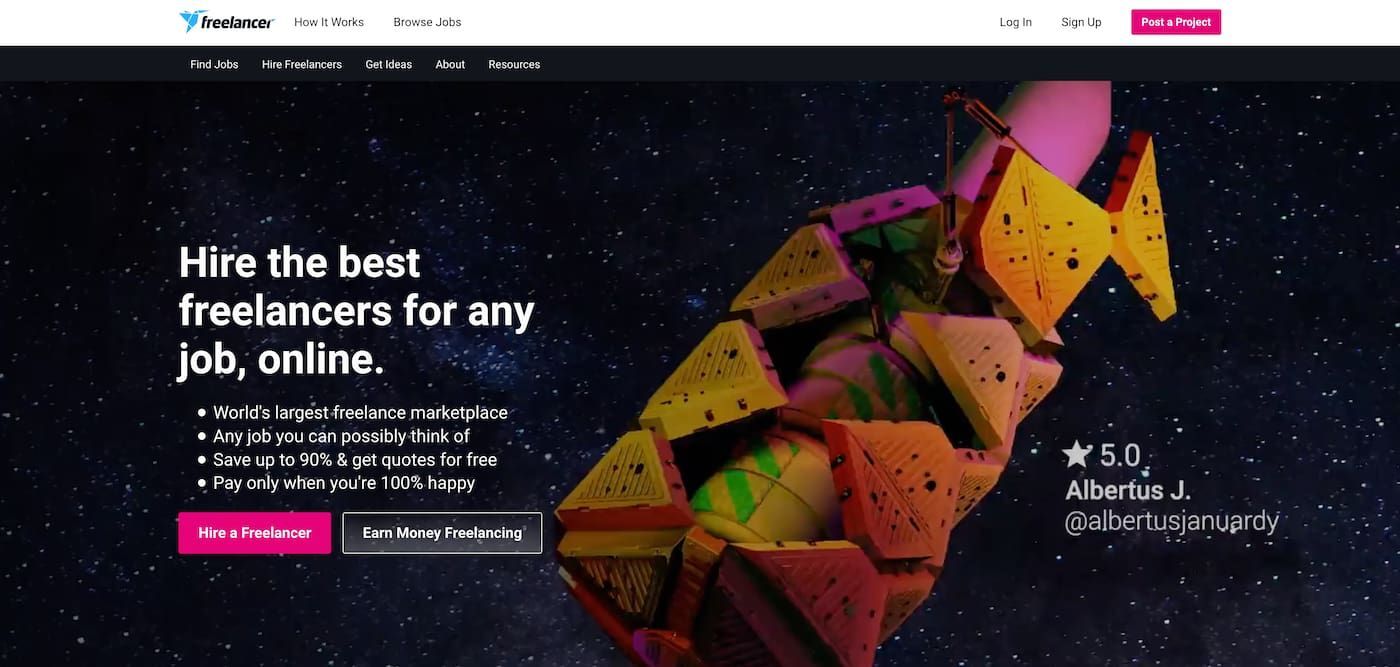
Freelancer serves as a popular marketplace connecting employers and independent contractors worldwide, facilitating job postings and bids through a competitive tender process.
Apart from offering job postings, this gig economy platform features contests that members can host and participate in, offering prize money as rewards for contributions.
Users can build their profiles on the site to showcase their skills, track work history, and receive reviews from collaborators, enhancing their transparency and credibility.
Freelancer's extensive user network spans 247 countries, providing access to gig workers mostly from India, the United States, the Philippines, Pakistan, and the United Kingdom.
The platform predominantly caters to IT, design, and media jobs, with writing and content creation making up around 13%.
Pros:
- The site hosts a massive job database, offering numerous gig economy job opportunities.
- There are comprehensive B2B communication tools for freelancers and employers.
- The platform allows freelancers to choose from various payment options.
Cons:
- You should be aware of scam listings, but there is a Report User button to alert the administrators.
- For beginners, the rates can be low, but over time, this will increase.
- Being a competitive platform, it may be harder to secure the best gig economy jobs without established credentials.
Bottom Line:
Freelancer is a popular gig economy platform with an impressive job database and global reach, particularly in the IT, design, and media sectors.
However, new users should be cautious about potential scams, and beginners may face lower initial rates, while competition can be challenging before establishing their credentials.
1. Upwork
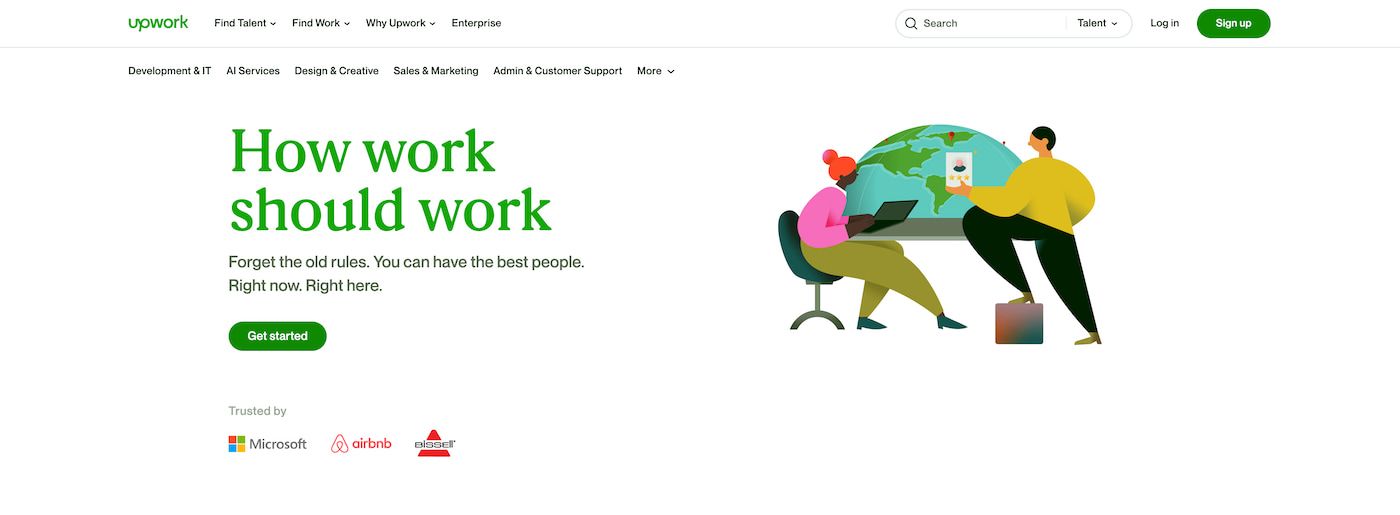
Upwork is one of the most widely used online marketplaces connecting freelancers with clients seeking services in writing, design, and programming.
The site uses a bidding system where freelancers have the opportunity to submit their proposals and bid on projects posted by potential clients.
The clients then select freelancers based on their proposals, evaluating their skills and expertise and interviewing them before making a final choice.
Once the work is allocated, Upwork offers an all-in-one platform with integrated payment processing, communication, and project management features.
There's no need to worry about getting paid as Upwork has a vetting process to ensure the legitimacy of projects, providing a secure environment.
For those new to gig work, Upwork provides various educational resources and a responsive help desk to support freelancers.
Pros:
- Upwork's comprehensive platform tools include embedded payment, scheduling, and communication features.
- Both freelancers and businesses go through a thorough vetting process to ensure secure payments and reliable work.
- Freelancers enjoy various support options, including educational resources and a responsive help desk.
Cons:
- Having been around for a while, Upwork has a high number of freelancers, resulting in increased competition for jobs.
- Crafting proposals on Upwork may take time, impacting your productivity.
- While they are needed, random ID checks and security measures can be intrusive and frustrating.
Bottom Line:
In our opinion, Upwork is the best platform to help you find gig work in 2024, as its integrated tools, payment processes, and thorough vetting are excellent.
However, the platform is very competitive, so it can be challenging for new freelancers to initially craft proposals that win bids.
Summary
This comprehensive overview of top gig economy platforms will help you decide which ones give you the best chance of securing jobs quickly and efficiently.
With options ranging from Upwork, offering high relative pay and diverse opportunities, to platforms like Freelancer and Uber, there's something for every freelancer's needs.
In a world where tech advancements help drive workplace transformations, the gig economy has emerged as one of the best ways to maintain work-life balance.
Adrian Mole is a UK-based Chartered Accountant and Chartered Tax Adviser. With a career spanning over 30 years, he has advised clients of all sizes on accounting, business, and tax matters and has a passion for helping startups. Formerly a partner of a Top Ten accounting firm in London, he now runs a small accounting practice closer to home with a committed team of finance professionals. A private pilot and keen scuba diver, when not working, he enjoys time with his family and teaching Ballroom dancing.
– Recommended Reads –
The information found on this website is for general purposes only and should not be considered financial advice. The Positive Accountant is an opinion and information based website only. Please do your own research and consult with a qualified professional before making any financial decisions.




